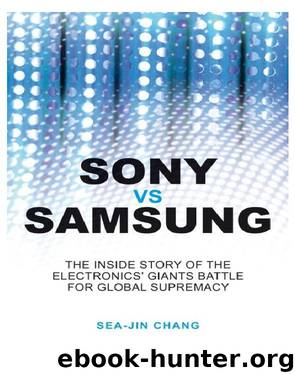Sony vs Samsung by Sea-Jin Chang

Author:Sea-Jin Chang
Language: eng
Format: epub
Publisher: John Wiley & Sons, Ltd.
Published: 2011-02-21T16:00:00+00:00
Return to a Global Organization
After Samsung Group’s regional HQ system was dissolved, Samsung Electronics restructured into a Global Product Manager (GPM) organization in 1998. The GPM organization structure comprised 17 business divisions such as TVs, VCRs, mobile communications, and so forth. Each took charge of global production and sales organization for its products at the Korean HQ, and the GPM head located in Korea made all important decisions regarding strategies, technical support, pricing, and production scheduling, and had bottom-line responsibility.
The local organizations executed a GPM’s decisions according to local conditions. A manager commented on this plan: “The GPM system would be difficult to work if the products radically differed in each nation, but Samsung Electronics’ products are mostly global. There’s no need to make different products for each nation, and there’s not much need for localization. I think the current GPM system is fine. Some small differences according to each market can be made easily by using different parts. The designs remain the same. The pricing decision is made by GPMs at the HQ, and all I have to do is focus on enhancing productivity. My goal is simply to increase the productivity and save more on material costs.”11
Others, however, believed that the GPM system was insensitive to local needs. A local manager pointed out, “The past European HQ system developed marketing strategies that took local conditions into consideration such as local management, promotion and education. Especially in Europe, the industrial relations issue had to be managed in a comprehensive way, encompassing the entire European region by having a multi-national corporate form rather than let each nation manage its own problems; so, we made the Samsung New Management Committee, which could be considered as the solution, and dealt with the industrial relations issues in the overall European region. But now, the whole system is centralized, moving just as the GPM instructs, and manufacturing subsidiaries have to follow GPMs’ orders regarding production quantity or pricing. Therefore, it has grown more difficult for the GPM system to respond to local conditions.”12 Some managers noted another problem: “We are now centralized again under the GPM organization. The GPM heads tend to be engineers who built up their careers in production and design centers. Their primary concern is to increase production efficiency. They do not know much about sales, or they don’t have any experience running business overseas. They can manage the sales of existing products, but might not be able to invest in new products or build distribution channels.”13 Another problem of the GPM system was that local subsidiaries became cost centers rather than profit centers, and thus lost the incentive to develop new products or open new markets.
Samsung Electronics changed the organization structure again in 2001 from GPM to GBM (Global Business Manager). GBM is almost equivalent to GPM, but uses “business” rather than “product” to widen managers’ perspectives from a focus on products to a focus on the whole industry. The change was supposed to widen the scope of products that
Download
This site does not store any files on its server. We only index and link to content provided by other sites. Please contact the content providers to delete copyright contents if any and email us, we'll remove relevant links or contents immediately.
The Rape of Nanking by Iris Chang(3530)
The Sympathizer by Viet Thanh Nguyen(3528)
World without end by Ken Follett(3015)
Ants Among Elephants by Sujatha Gidla(2930)
Blood and Sand by Alex Von Tunzelmann(2615)
Japanese Design by Patricia J. Graham(2563)
City of Djinns: a year in Delhi by William Dalrymple(2140)
Inglorious Empire by Shashi Tharoor(2106)
In Order to Live: A North Korean Girl's Journey to Freedom by Yeonmi Park(2063)
Foreign Devils on the Silk Road: The Search for the Lost Treasures of Central Asia by Peter Hopkirk(2061)
Tokyo by Rob Goss(2024)
India's Ancient Past by R.S. Sharma(1991)
India's biggest cover-up by Dhar Anuj(1990)
The Great Game: On Secret Service in High Asia by Peter Hopkirk(1963)
Tokyo Geek's Guide: Manga, Anime, Gaming, Cosplay, Toys, Idols & More - The Ultimate Guide to Japan's Otaku Culture by Simone Gianni(1953)
Goodbye Madame Butterfly(1941)
The Queen of Nothing by Holly Black(1768)
Living Silence in Burma by Christina Fink(1737)
Batik by Rudolf Smend(1726)
